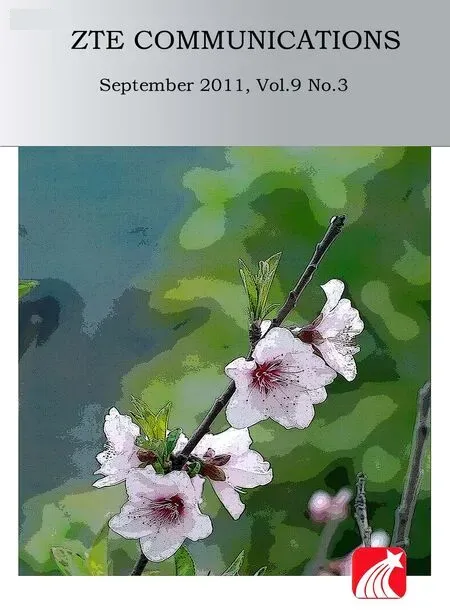Research on LTE Network Coverage Planning
(ZTE Corporation,Shenzhen 518004,P.R.China)
With increasing demand for wireless services,the capacity of 2G and 3G networks is reaching saturation point.To deal with the shortage of mobile network resources,3GPP has proposed Long Term Evolution(LTE),and this is now developing from theory into practice.With powerful service bearing capability,efficient resource utilization,low network construction and operation costs,and flexible network deployment,LTE has won favor from leading operators around the world[1].
Mature LTE standards are necessary for promoting the industry.With 3GPP freezing Release 8 in 2008,LTE standards are now in a mature state.Telecom equipment manufacturers are now conducting R&D on LTE products,and deployment of pilot offices and related tests are progressing well.Despite substantial progress in LTE research,complexity and flexibility in LTE systems brings uncertainty.The telecom industry is still exploring system features,network construction approaches,and optimization strategies.In terms of LTE network planning,the lack of systematic theory and application solutions is still a problem.
LTE systems adopt advanced radio link technologies in the air interface,including Orthogonal frequency-division Multiplexing(OFDM),multiple-input multiple-output(MIMO),adaptive modulation and coding(AMC),and hybrid automatic repeat reQuest(HARQ).It also applies radio resource configuration algorithms—such as dynamic scheduling and inter-cell interference coordination(ICIC)—as well as power control to increase efficiency and flexibility in air interface resource configuration[2],[3].From the perspective of LTE network design,these technologies and algorithms improve network performance but increase system complexity as well.To work out an efficient,reliable network coverage planning scheme for LTE,it is necessary to study the system’s technical features comprehensively using system theories,simulations,and tests.Compared with 2G and 3G networks,LTE has quite different core factors that affect its coverage performance,including resource sharing mode and system interference characteristics.Traditional coverage planning and link budget schemes are far from adequate for LTE[4].When planning the coverage of an LTE system,it is first necessary to analyze the potential requirements of LTE network construction and dissect the technical and network features.Then,a coverage architecture can be worked out that is feasible for LTE network construction and that can be improved constantly.Improving spectral efficiency is the key to creating a competitive edge with LTE.This paper focuses on spectral efficiency as well as LTE network design in the context of same-frequency networking.
1 LTE Network Planning Process and Coverage Planning Strategy
For frequency-division duplexing(FDD)LTE,network planning is similar to that of 2G and 3G networks.The planning process involves five stages:requirement collection and analysis,coverage and capacity design,site selection,simulation,and report preparation.Of these,coverage and capacity design is the core of the entire process.For this design,network characteristics need to be thoroughly analyzed,and network size needs to be evaluated based on the actual demands of customers.This paper analyzes coverage planning methods for LTE system.
For FDD LTE systems,the main goal of coverage planning is to estimate the coverage distance of an eNodeB with parameter settings based on actual cell edge coverage requirements in order to meet network size requirements.Planning strategies for FDD LTE system coverage can be divided into three kinds according to application scenario and requirements:
·network size estimation based on uplink edge rate requirement.This strategy is mainly applied in coverage scenarios where only the uplink edge rate is limited.The uplink coverage radius is calculated using the uplink rate and related link budget parameters.Then the downlink edge rate is predicted from the uplink coverage radius.
·network size estimation based on downlink edge rate requirement.This strategy is mainly applied in coverage scenarios where only the downlink edge rate is limited.The downlink coverage radius is first calculated using the downlink rate and related link budget parameters.Then,the uplink edge rate is predicted from the downlink coverage radius.
·network size estimation based on uplink and downlink edge rate requirements.This strategy is mainly applied in coverage scenarios where both uplink and downlink edge rates are limited.The uplink and downlink coverage radiuses are calculated using the uplink and downlink rates and related link budget parameters.Then,the limited coverage radius is obtained by comparing the uplink coverage radius with downlink coverage radius.
In network planning,a proper coverage planning strategy is selected according to actual requirements of the application scenario,and it must be able to flexibly handle problems that occur.
2 Key Technologies for LTE Uplink Coverage Planning
The key issue for coverage planning in LTE is how to work out the coverage based on the edge service rate requirements in the uplink or downlink.In some special scenarios or services,the coverage performance of the control channel must also be taken into account.Here we mainly discuss coverage planning in scenarios where the service channel is limited.Suppose the service rate is given,network coverage planning requires analysis of technical characteristics of the links and system.
Research on uplink coverage planning technologies is mainly focused on links and system.In the LTE uplink,single carrier frequency division multiple access(SC-FDMA)is introduced as the multiple access scheme,and users within a cell are orthogonal.
Most interference comes from active users of neighboring cells.Consequently,the selection of uplink power control policies directly impacts the inter-cell interference mode and interference density[5],[6].In LTE uplink coverage design,interference margin is critical for network planning.Its value is mainly dependent on power control technique and application scenario.To obtain a feasible reference setting for the interference margin in uplink coverage planning,it is necessary to study the interference in different contexts by using system-level simulation.
Depending on the focus of network construction,uplink interference features may be affected by power control strategies or other factors.For LTE systems,the direct measurement for uplink interference features is average interference over thermal(IoT)level.The distribution of uplink IoT depends on actual application scenarios and uplink power contr0ol parameters.The power control scheme in LTE uplink includes open loop power control and closed loop power control.Normally,open loop power control determines the interference mode of the system,and closed loop power control is used to adjust the system parameters in response to changes in service or interference during network operation.Open loop power control meets specific network design requirements by setting suitable power control parametersP0andα.Different combinations of these parameter settings bring about different network coverages and capacities.To work out a network planning scheme for a specific scenario,it is necessary to analyze the settings of the parameters in various application scenarios in order to find out which settings meet the requirements.It is also necessary to study the system’s IoT as well as the uplink interference margins in different parameter settings.Analyses show that different parameter settings lead to differentiated system performance indexes and interference features.In actual planning,it is necessary to select proper parameter settings according to system coverage and capacity requirements.The relation between mean IoT and the parameterP0is shown in Fig.1.

Figure 1.Relationship between meanIoTandP0.
In the early stage of LTE network construction,design is focused on coverage.Power control parameters are used to reduce interference and achieve maximum coverage.Because the target load varies from one network to another,the network interference level under different loads,as shown in Fig.2,should be considered as a reference for coverage planning.
At the link level,uplink coverage design is primarily concerned with optimal configuration of user bandwidths at given data rates.Special edge data rate requirements can be met by assigning users different bandwidths.However,this may result in different coverage performance.By studying channel capacity and analyzing link-level simulation results it can be seen that optimizing bandwidth configuration at a given data rate enhances coverage.In uplink coverage design,the following should be taken into consideration and analyzed:link performance in link simulations and actual system tests,power efficiency of the terminals,and system performance at given data rates and with different user bandwidth allocations.From these analyses,optimal uplink bandwidth configuration can be obtained for different service rates,and good coverage can be achieved.Fig.3 shows the relationship between data rate and optimal uplink bandwidth configuration.
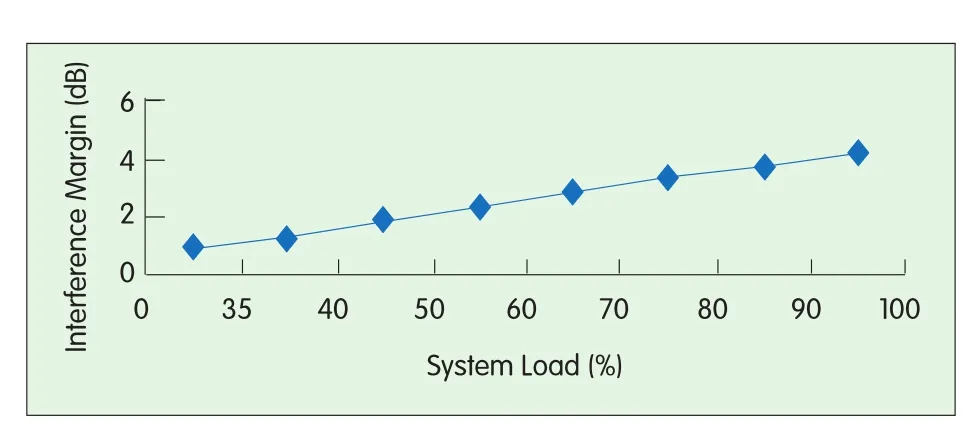
Figure 2.Uplink interference margin versus system load.
With the above system-and link-level analyses,the two core elements for uplink budget can be determined:interference margin and uplink transmission bandwidth(the corresponding modulation and coding scheme(MCS)and signal to interference plus noise ratio(SINR)should be worked out with link simulation).Then,the maximum allowed path loss(MAPL)of the uplink at a given edge rate can be calculated based on traditional link budget and calculation methods.
3 Key Technologies for LTE Downlink Coverage Planning
As in the uplink,coverage planning in the downlink also involves the links and system.In researching link technologies,simulations with different link settings,such as MCS and bandwidth,should be performed to determine the link quality(carrier to interference ratio(CIR))requirements in different channel environments and at different service rates.The simulation results are then used as the basis for coverage planning.In system-level research,system simulations are performed to determine how received signal strength,interference density,interference margin,and CIR change with the application scenario and coverage range.The purpose of these analyses is to understand the limitations of traditional link budget schemes(based on interference margin)and to find out the relationship between signals and interference.In this way,existing coverage planning methods can be improved.
Interference in the downlink is affected by networking mode(interference coordination method)and system load,and it varies with the cell radius.The critical parameter of link budget,the interference margin,also changes with the cell radius,as shown in Fig.4.Because of the strong correlation between interference margin and cell radius,the traditional method whereby the cell radius is calculated using a given interference margin is no longer applicable.Hence,new,relatively stable intermediate parameters have to be worked out for cell coverage analysis.
Analysis of a large number of systems shows the geometry factor(GF),with its unique characteristics,is an ideal bridge for downlink budget.GF is defined as the ratio of the signal to interference plus noise.Under full load and with same frequency networking—that is,frequency reuse factor is 1—the GF’scumulative distribution functions(CDFs)in the case of different cell radiuses show that the distribution of GFsalmost overlap under different coverage radiuses,as shown in Fig.5.This characteristic of GF makes it a stable intermediate parameter for LTE downlink budget.
In network design,GF corresponding to a coverage area of 95%is often selected as the reference for coverage planning.Simulation under conditions of same frequency networking and full load shows the GF is 3 dB,as shown in Fig.6.In an actual network,the design objectives are different and GF varies with the system load.It is therefore necessary to work out the GF reference values for different loads.Once the GF reference value is obtained,a definite mathematical relationship between the GF and SINR can be established for downlink coverage analysis.Specifically,in actual link budget,the SINR required by the downlink edge is determined by specific requirements.Then the minimum received signal strength required by the edge is calculated.Finally,the MAPL is worked out from the transmit power of the eNodeB.The formulae for these calculations are as follows:

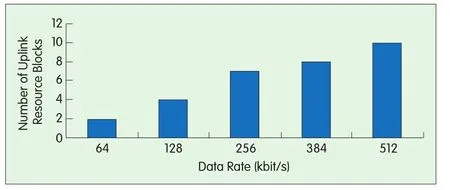
Figure 3.Optimal uplink bandwidth configuration at given data rates.
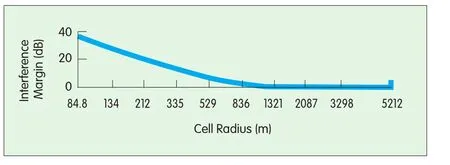
Figure 4.Downlink interference margin versus cell radius.
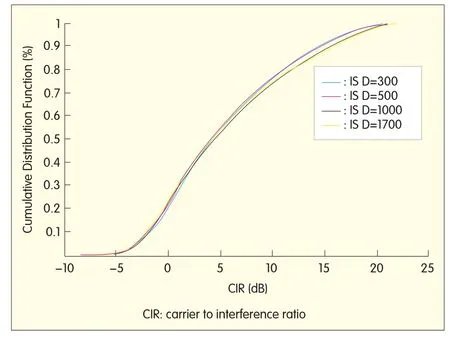
Figure 5.Cumulative distribution function of downlink CIR.

Figure 6.Relation between geometry factor and system load.

whereSINRrequireis the required SINR,Srequireis the minimum receiving power required by the receiving end,Pis eNodeB’s transmit power,sh_marginis shadow margin,Lossis the loss of all devices including feeders,andGainis the gain of all devices including antennas.
4 Conclusions
The openness and flexibility of LTE networks brings great challenges to network design.On the whole,research on LTE networking is still exploratory.This paper introduces the LTE network planning and requirements and analyzes key technologies for coverage planning and system features.Based on these analyses,it gives approaches to LTE network planning for different coverage requirements.These approaches provide guidance for converting commercial demands into technical demands.Moreover,this paper presents overall technical approaches to uplink and downlink budget of LTE systems and analyzes the settings of critical parameters and their applications.Thus,it lays the basic foundations for LTE network design.
[1]S.Sesia,I.Toufik,and M.Baker,LTE,The UMTS Long Term Evolution:From Theory to Practice,John Wiley,New York:2009.
[2]Evolved Universal Terrestrial Radio Access(E-UTRA)and Evolved Universal Terrestrial Radio Access Network(E-UTRAN):Overall Description,3GPP TS36.300,2008.
[3]Evolved Universal Terrestrial Radio Access(E-UTRA):Physical Layer Procedures,3GPP TS 36.213,2008.
[4]Syed Abdul-Basit,“Dimensioning of LTE network:description of models,tools,coverage and capacity estimation of 3GPP LTE radio interface,”M.S.thesis,Dept.Elect.Commun.Eng.,Helsinki Uni.Tech.,Finland,2009.
[5]N.J.Quintero,“Advanced Power Control for UTRAN LTE Uplink,”M.S.thesis,Dept.Elect.Syst.,Aalborg University,June 2008.
[6]B.Muhammad,“Closed Loop Power Control for LTE Uplink,”M.S.thesis,School Eng.,Blekinge Inst.Tech.,Sweden,2008.
- ZTE Communications的其它文章
- The Internet of Things and Ubiquitous Intelligence(3)
- ZTE Brings International Mobile Hotspot to Sprint Customers
- ANTEL Selects ZTE for Uruguay National GOON Project
- ZTE,Telkom Kenya-Orange Announce Nations' Fastest Commercial HSPA+ Network
- Security Service Technology for Mobile Networks
- Advances in Digital Front-End and Software RF Processing:Part I

